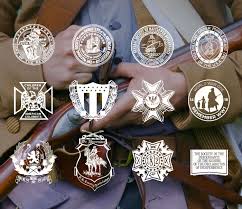
Most of my client work this past summer has been for assistance in joining a lineage society. The reasons for the interest varied; one elderly gentleman wanted to give memberships to grandchildren as holiday gifts, several had affiliating with an organization on their bucket list and decided the time was right to pursue membership, and a few wanted to memorialize an ancestor.
In most of the cases of the clients who contacted me, they didn’t need much help. They actually didn’t need me at all which I told them. Joining a lineage society is not difficult although some have more stringent requirements than others in validating the provided evidence.
If you’re thinking of joining, you will first need to establish a relationship from yourself to the ancestor who would qualify for the society. That means, proving you’re connected to your parent and your parent is connected to your grandparent and so on until you reach the qualifying ancestor. For most people, obtaining vital statistics aren’t difficult; they just require completing a form, submitting payment and being patient to wait for the document to arrive. Creativity comes into play when the ancestor lived prior to required vital records being available. In those cases, church, Bible, cemetery, immigration, pension, and wills might be used to prove the relationship.
If you have a known relative who is a member of the lineage society you wish to join, most of your work is already done for you. All you need to do is prove your connection to the member.
What seemed to be my clients’ biggest hurdle was in following the direction of the society’s application. One individual told me he had once had a high security clearance for his job and that paperwork was simple compared to a state lineage society application. If this is your roadblock, here’s some tips to get the job done:
1. Make sure your ancestor meets the society’s requirements. This sounds silly but it isn’t. If you’re trying to join a county Pioneer Program, for example, your ancestor must have lived in that county during the years the program stipulates. Boundaries change and that may make your forefather ineligible. West Virginia was once part of Virginia, Pinellas County in Florida was once part of Hillsborough County. Check out the area’s history before beginning will save you time and money.
2. Make a copy of the application and use a pencil to print the information it requests. This way, you can eliminate the worry of a web fill in the blank document not saving and you can have a hard copy to verify each connection. It’s much simpler to have all the information on one handy dandy form to type into the society’s online application than to try to flip pages of all your proof documents to find the required data and input it at the same time.
3. I recommend checking off each name, date and location that you recorded on the hard copy application by looking back at the record used. For example, if the birth certificate states the name is Mary Ellen then that name should be recorded on the application and not Elle, the individual’s nickname. Nicknames should be included if they are found in official documents. I had a several times great grandmother that completed a War of 1812 widow’s pension under her nickname, Polly. Her birth name was Mary. She was illiterate and didn’t sign the pension application but Mary and Polly were used interchangeably on the document. In situations like this, I would write Mary Polly on the application.
4. If you have questions as you complete the form, simply email the society’s contact person. In most cases, they will be helpful as a good society values new members. My opinion, if they aren’t helpful then why would you want your ancestor’s name affiliated with them?! Save yourself grief and memorialize in a different way.
5. When you submit the application, make sure you’ve kept a copy as there may be a question or two and you can readily have your own set to refer to as you respond to the question.
I have found that awaiting confirmation of membership is often a slow process so patience is required. Most societies are composed of volunteer members so your application is reviewed around their spare time.
Not sure what lineage societies are available? Check out this Wiki list. Warning – that is not a complete list as many more societies are available. Contact historical and local genealogical societies for additional opportunities.



